

*Kathy Schrock: Literacies in the Digital Age. I have identified thirteen literacies that our students need to become well-rounded 21st-century citizens.
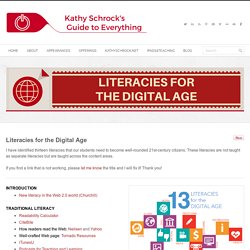
These literacies are not taught as separate literacies but are taught across the content areas. If you find a link that is not working, please let me know the title and I will fix it! Thank you! There is a new book out, Developing Digital Literacies, by Dustin Summey. He presents a well-crafted, technology professional development model that is sound in practice, adaptable, and can be easily implemented at the local level. *Definition of Literacy in a Digital Age - NCTE. *What are the 4Cs? *7 Things That Happen When Students Own Their Learning.
*Examine What Makes a Literacy in the May/June Issue. A few years ago, at an ALA Annual Conference, I found myself experiencing a very peculiar day.

Besides my standard sessions on information literacy, I attended sessions on civic literacy and news literacy, as well. There were conversations in hallways about digital literacy, but also about disciplinary literacy and financial literacy. For some time I’d been following discussions of transliteracy–“the ability to read, write and interact across a range of platforms, tools and media from signing and orality through handwriting, print, TV, radio and film, to digital social networks” (Thomas 2007); this was a different use of the term “literacy” altogether, not focused on forms of media as much as on areas of knowledge. It started to feel a bit dizzying, and I wondered why all these different skills were being called literacies. Are there any common characteristics that unite them in meaningful ways? Reference Thomas, Sue, et al. About the Guest Editors Table of Contents Features Articles. *Belshaw: Zen and the Arts of Digital Literacies. The PDF file you selected should load here if your Web browser has a PDF reader plug-in installed (for example, a recent version of Adobe Acrobat Reader).
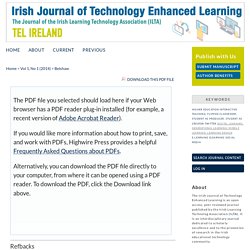
If you would like more information about how to print, save, and work with PDFs, Highwire Press provides a helpful Frequently Asked Questions about PDFs. Alternatively, you can download the PDF file directly to your computer, from where it can be opened using a PDF reader. To download the PDF, click the Download link above. 2017 nmc cosn horizon report k12 preview. Future Librarians: Pro-Literacy & Everything in Between - EasyBib Blog. From Written to Digital: The New Literacy. Both the 21st-century economy and the careers needed to fuel it are changing at an unprecedented rate.

Students must be prepared for nonlinear careers, pivoting to match the ever-changing work landscape. We thus need to rethink not just how we teach our students but what we teach our students. The people who were comfortable at this humanities-technology intersection helped to create the human-machine symbiosis that is at the core of this story. In his book about the history of the digital revolution, Walter Isaacson contends that the major innovations of the digital revolution—from the first general-purpose computer to the transistor to the iPhone—were all created by individuals who understood how to synthesize the humanities with technology. Yet even though there is much focus in higher education on how we teach using technology (e.g., e-texts, flipped classrooms, adaptive learning, personalized learning), what we teach about technology is just as important. Control/Alt/Read: Reading Digital Text in the Plugged In Classroom of the 21st Century.
Ifla digital literacy statement. School Librarians Poised To Support Student Success, Information Literacy Survey Shows. *Howard Rheingold - Net Smart: How to Thrive Online. ASCD Express 12.12 - Disciplinary Literacy: A Shift That Makes Sense. NCTE Literacy in Digital Age Quotes. » Horizon Report (Scan K12summary for edtech trends, challenges & developments) Belshaw: How to Develop Digital Literacies in yourself and others. Belshaw: The Essential Elements of Digital Literacies. Providing Classroom Leadership in New Literacies: Preparing Students for Their Future. Digital Literacy and Learning in the United States.
Web Literacy - Mozilla Learning. AdolLitResearchBrief (NCTE) Kajder: Adolescents and Digital Literacies (Chapter 1) Seven Strategies to Teach Students Text Comprehension. 1.
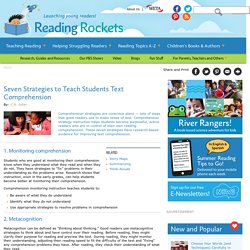
Monitoring comprehension Students who are good at monitoring their comprehension know when they understand what they read and when they do not. They have strategies to "fix" problems in their understanding as the problems arise. Research shows that instruction, even in the early grades, can help students become better at monitoring their comprehension. TPACK.ORG. 2017 nmc cosn horizon report k12 preview.
What are the 21st-century skills every student needs? The gap between the skills people learn and the skills people need is becoming more obvious, as traditional learning falls short of equipping students with the knowledge they need to thrive, according to the World Economic Forum report New Vision for Education: Fostering Social and Emotional Learning Through Technology.

Today's job candidates must be able to collaborate, communicate and solve problems – skills developed mainly through social and emotional learning (SEL). Combined with traditional skills, this social and emotional proficiency will equip students to succeed in the evolving digital economy. What skills will be needed most? For Teachers. Standards For Students. Refreshed Pedagogy for the Contemporary Learner. Jason Ohler : Education and Technology. Part II.

Emergence of new media literacies Every day media create every day literacy and fluency needs Students need to be able to write new media, and teachers need to be able to assess it. Until recently, every day media forms were text-based. No longer. Leading the New Literacies: Digital, Media & Global. This blog comes from a session by Heidi Hayes Jacobs at ASCD conference March 15th, 2014.
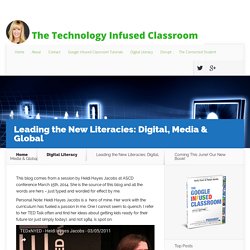
She is the source of this blog and all the words are hers – just typed and worded for effect by me. Personal Note: Heidi Hayes Jacobs is a hero of mine. Her work with the curriculum has fueled a passion in me. One I cannot seem to quench. I refer to her TED Talk often and find her ideas about getting kids ready for their future (or just simply today), and not 1984, is spot on. The New Literacies: Digital, Media and Global – The idea that we are teaching an entire day focused around print literacies and nothing about media is one of the fundamental problems with education.
Essential Question: How do we prepare our learners for their future, not 1990 which seems to be the year most schools are getting them ready for. 20 Creative Bloom's Taxonomy Infographics Everybody Loves Using. There is no shortage of Bloom’s Taxonomy infographics online for every teacher.
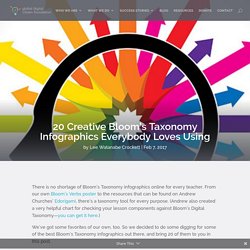
From our own Bloom’s Verbs poster to the resources that can be found on Andrew Churches’ Edorigami, there’s a taxonomy tool for every purpose. (Andrew also created a very helpful chart for checking your lesson components against Bloom’s Digital Taxonomy—you can get it here.) We’ve got some favorites of our own, too. So we decided to do some digging for some of the best Bloom’s Taxonomy infographics out there, and bring 20 of them to you in this post. If you’re like us, you enjoy experiencing other creative viewpoints and sharing them with those that you feel may benefit from them. Maybe you’re interested in descriptive verbs, or essential questions for each stage of the taxonomy. 2016 nmc horizon strategic brief digital literacy.
Framework for Information Literacy for Higher Education. Filed by the ACRL Board on February 2, 2015.

Adopted by the ACRL Board, January 11, 2016. This work is licensed under a Creative Commons Attribution-NonCommercial-ShareAlike 4.0 International License. PDF Version Print copies may be purchased from the Association of College and Research Libraries for $15.00 for a package of 10, including standard postage. Ducksworth: Sketchnote of ideas for inquiry-based learning. Educators Need to See Themselves As….
I am working hard on my and Janet Hale’s upcoming book, Documenting Learning- Making Thinking Visible, Meaningful, Shareable, and Amplified with Corwin Press. (Estimated date of publication: Spring 2018). As I am articulate why learners (and specifically educators) should see themselves as documenters, my mind wrapped itself around the following: Educators need to see themselves as more than covering content, lecturers or deliverers of prescribed/established curriculum. We live in a time, where we learn, how we learn, when we learn and with whom we learn changes at an exponential rate.
Now more than ever, we can’t rely on the old tried and tested methodology or practices, because the rules of what it means to teach and learn have changed. Silvia Tolisano- Langwitches Blog. Reflection is an important component of the learning process.